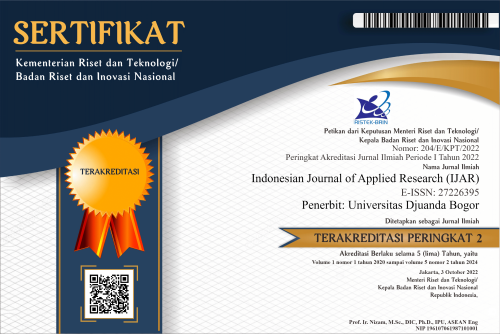Antibacterial Activity of Ethyl Acetat Fraction of Basil Leave (Ocimum Basilicum L) Toward Escherichia Coli Growth
Abstract
Antibiotic resistance to Escherichia coli is commonly found. Several studies have found that basil leaves contain chemical compounds: flavonoids, alkaloids, tannins, and saponins, which act as antibacterials. This research aimed to determine the inhibitory power of the ethyl acetate fraction of basil leaves (Ocimum basilicum L) on the growth of Escherichia coli. This study used a post-test-only control group design. This study contained five groups: one positive control group, one negative control group, and three treatment groups. The treatment group consisted of the ethyl acetate fraction of basil leaves at 12.5% μ, 25% μ, and 50% μ. The control group was a positive control K(+) with co-trimoxazole and a negative control K(-) with 10% Dimethyl Sulfoxide (DMSO). Kruskal walls test was chosen, followed by the Mann-Whitney difference test. In the Kruskal Walls test, a significant difference was found (p-value < 0.050) for basil leaf ethyl acetate fraction treatment. The largest average was obtained, namely the ethyl acetate fraction with a concentration of 12.5%. The Mann-Whitney test was carried out to determine fundamental differences between groups. The results of ethyl acetate fraction showed that the Minimum inhibitory concentration (MIC) for Escherichia coli was 12.5%.
References
Ali, H., & Dixit, S. (2012). Antioxidant Activity of Combined Extract of Some Medicinal Plants of Indian Origin. Chemistry of Phytopotentials: Health, Energy and Environmental Perspectives, 43–46. https://doi.org/10.1007/978-3-642-23394-4_9
Annisa, F. I. (2021). UJI AKTIVITAS ANTIBAKTERI FRAKSI ETIL ASETAT DAUN KEMANGI (Ocimum basilicum L.) TERHADAP BAKTERI Pseudomonas aeruginosa dan Staphylococcus aureus.
Croppi, G., Zhou, Y., Yang, R., Bian, Y., Zhao, M., Hu, Y., Ruan, B. H., Yu, J., & Wu, F. (2020). Discovery of an inhibitor for bacterial 3-mercaptopyruvate sulfurtransferase that synergistically controls bacterial survival. Cell Chemical Biology, 27(12), 1483–1499. https://doi.org/10.1016/j.chembiol.2020.10.012
Fruin, J. T., Idll, T. M., Clarke, J. B., Fowler, J. L., & Guthertz, L. S. (1977). Accuracy and speed in counting agar plates. Journal of Food Protection, 40(9), 596–599. https://doi.org/10.4315/0362-028x-40.9.596
Hadi, U., Kuntaman, K., Qiptiyah, M., & Paraton, H. (2013). Problem of antibiotic use and antimicrobial resistance in Indonesia: Are we making progress. Indonesian Journal of Tropical and Infectious Disease, 4(4), 5–8. https://doi.org/10.20473/ijtid.v4i4.222
Kumalasari, M. L. F., & Andiarna, F. (2020). Uji fitokimia ekstrak etanol daun kemangi (Ocimum basilicum L). Indonesian Journal for Health Sciences, 4(1), 39–44. https://doi.org/10.24269/ijhs.v4i1.2279
Larasati, D. A., & Apriliana, E. (2016). Efek potensial daun kemangi (Ocimum basilicum L.) sebagai pemanfaatan Hand Sanitizer. Majority, 5(5), 124–128.
Milani, B., Scholten, W., & World Health Organization. (2011). The world medicines situation 2011: Access to controlled medicines. World Health Organization.
Mogi, B. C., Harjanti, R., & Samsumaharto, R. A. (2016). Uji aktivitas antibakteri ekstrak etanol, fraksi n-heksana, etil asetat, dan air dari daun Turi (Sesbania grandiflora Pers) terhadap bakteri Shigella dysenteriae ATCC 9361. Biomedika, 9(2), 30–35.
Mosisa, D., Aboma, M., Girma, T., & Shibru, A. (2021). Determinants of diarrheal diseases among under five children in Jimma Geneti District, Oromia region, Ethiopia, 2020: A case-control study. BMC Pediatrics, 21, 1–13. https://doi.org/10.1186/s12887-021-03022-2
Mustika, A. D. (2014). Uji Aktivitas Antibakteri Fraksi Etanol Daun Kemangi (Ocimum Basilicum L.) terhadap Pertumbuhan Salmonella Typhi secara In Vitro. Jurnal Mahasiswa PSPD FK Universitas Tanjungpura, 3(1).
Rachmawati, S., Oktima, W., & Andareas, P. (2021). Uji aktivitas antimikroba fraksi daun jeruk lemon (Citrus limon (L.) Osbeck) terhadap Stapylococcus aureus dan Escherichia coli. Jurnal Pro-Life, 8(1), 72–81.
Roni, A., Maesaroh, M., & Marliani, L. (2018). Aktivitas antibakteri biji, kulit dan daun pepaya (Carica papaya L.) terhadap bakteri Escherichia coli dan Staphylococcus aureus. Kartika: Jurnal Ilmiah Farmasi, 6(1), 29–33. https://doi.org/10.26874/kjif.v6i1.134
Slobodníková, L., Fialová, S., Rendeková, K., Kováč, J., & Mučaji, P. (2016). Antibiofilm activity of plant polyphenols. Molecules, 21(12), 1717. https://doi.org/10.3390/molecules21121717
Soesetyaningsih, E., & Azizah, A. (2020). Akurasi perhitungan bakteri pada daging sapi menggunakan metode hitung cawan. Berkala Sainstek, 8(3), 75–79. https://doi.org/10.19184/bst.v8i3.16828
Sunarno, S., Puspandari, N., Fitriana, F., Nikmah, U. A., Idrus, H. H., & Panjaitan, N. S. D. (2023). Extended spectrum beta lactamase (ESBL)-producing Escherichia coli and Klebsiella pneumoniae in Indonesia and South East Asian countries: GLASS Data 2018. AIMS Microbiology, 9(2), 218. https://doi.org/10.3934/microbiol.2023013
Vranic, S. M., & Uzunovic, A. (2016). Antimicrobial resistance of Escherichia coli strains isolated from urine at outpatient population: A single laboratory experience. Materia Socio-Medica, 28(2), 121. https://doi.org/10.5455/msm.2016.28.121-124
World Health Organization. (2014). Maternal mortality. https://www.who.int/news-room/fact-sheets/detail/maternal-mortality
Copyright (c) 2024 Indonesian Journal of Applied Research (IJAR)

This work is licensed under a Creative Commons Attribution-ShareAlike 4.0 International License.
The Authors submitting a manuscript do so on the understanding that if accepted for publication, copyright publishing of the article shall be assigned/transferred to Indonesian Journal of Applied Research (IJAR) Universitas Djuanda as Publisher of the journal. Upon acceptance of an article, authors will be asked to complete a 'Copyright Transfer Agreement'. An e-mail will be sent to the corresponding author confirming receipt of the manuscript together with a 'Copyright Transfer Agreement' form by online version of this agreement.
Indonesian Journal of Applied Research (IJAR) Universitas Djuanda, the Editors and the Editorial Board make every effort to ensure that no wrong or misleading data, opinions or statements be published in the journal. In any way, the contents of the articles and advertisements published in the Indonesian Journal of Applied Research (IJAR) Universitas Djuanda are sole and exclusive responsibility of their respective authors and advertisers.
Remember, even though we ask for a transfer of copyright, our journal authors retain (or are granted back) significant scholarly rights as mention before.
The Copyright Transfer Agreement (CTA) Form can be downloaded here: Copyright Transfer Agreement-IJAR 2020
The copyright form should be signed electronically and send to the Editorial Office e-mail below:
Prof. Dr. Ir. Dede Kardaya, M.Si. (Editor-in-Chief)
Universitas Djuanda
Jl. Tol Jagorawi No.1, Ciawi, Kec. Ciawi, Bogor, Jawa Barat 16720
Website: http://journal.unida.ac.id/index.php/IJAR/index
Email: ijar@unida.ac.id






 This work is licensed under a
This work is licensed under a 